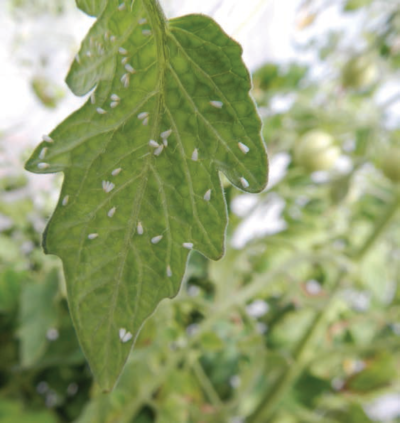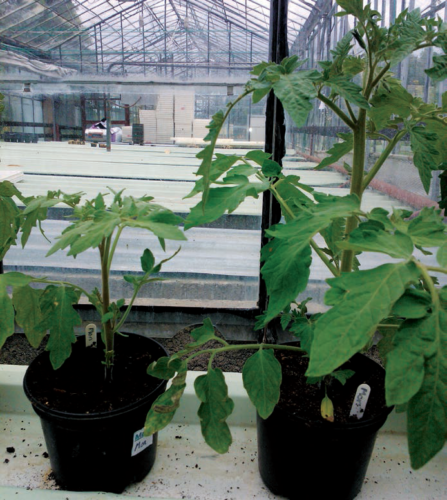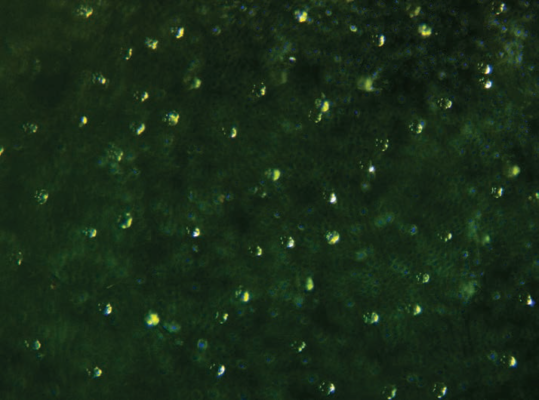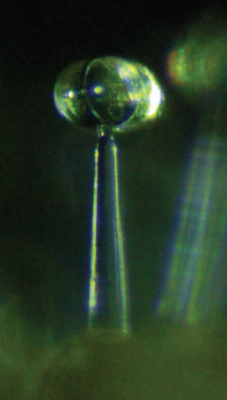Sam Belton, plant biology student at UCD shares results from commercially beneficial research he undertook as part of his undergraduate thesis
All plants possess innate or ‘constitutive’ mechanisms of defending themselves against various stresses imposed on them from their environments or from pests and diseases. These range from waxy leaf surfaces that serve to mitigate water loss, to the physiologically more complex, such as volatile (chemical) signalling between neighbouring plants, which helps prime or warn them for future pest or pathogen attacks.
Trichomes are the leaf hairs found on about a third of all vascular plant species. Apart from providing an attractive downy or pubescent leaf texture to various ornamental plant species, they are highly important in forming a first-line, defensive barrier against many agronomically damaging environmental stresses.
The tomato plant (Solanum Lycopersicum) produces many trichome types of different shapes. Some of these leaf hairs have glands which hold copious amounts of aromatic chemical compounds and anti-nutritious defensive proteins. The type VI trichome is a good example of one such glandular trichome and comprises a short stalk and a four-celled glandular head (see photo 1 above). At only 0.3mm in length, this trichome type is present on almost all above-ground tissues of tomato plants and they are the most important type of trichome to be found on tomatoes, from an insect herbivory perspective. Recent laboratory studies of mutated tomato plants that have significantly lower densities of the type VI trichome have indicated that they are compromised in their defence against insect pests. These trichomes work by rupturing in response to physical contact with insects, which causes them to release their chemical contents. These compounds then rapidly oxidise forming a sticky, brownish exudate that can entrap insects, causing them to suffocate, starve or to succumb to toxic properties of the substances.
As consumer and environmental pressures demand greater reductions in the use of synthetic pesticides, developing tomato varieties with genes from wild tomato species to increase both type VI trichome density and the concentrations of different chemical compounds within them is an area of high interest. Thoroughly understanding how trichomes work as weapons against such pest species in the cultivated tomato is, therefore, something that needs to be investigated further.
One interesting characteristic of trichomes is that whilst being constitutively present (ie, always present at some basal level) on tissues such as leaves, stems and floral organs, they can also be induced. What this means is that their densities can increase or decrease depending on factors such as plant growth state and the presence or absence of certain environmental stimuli. For example, stinging nettles subject to herbivore grazing and mechanical damage grow back with increased trichome density. Extensive tissues damage is, therefore, something that elicits increased trichome density in many plant species, and tomato plants are no exception.
Understanding this, we looked at how whitefly infestation affects type VI trichome density. The greenhouse whitefly (Trialeurodes vaporariorum) is one pest that is synonymous with both Irish and international tomato crop production. Typically found feeding on the lower leaf surfaces of young leaves, their most concerning attribute as a pest is their ability to act as vectors for economically important viruses, such as tomato chlorosis virus and tomato yellow leaf curl virus. As sap-sucking insects, whitefly inflicts minimal tissue damage, indicating that they should have little to no effect on trichome density.
“Whitefly have been shown to trick their host plant into perceiving them as pathogens”

Moreover, whitefly can trick their host plants into perceiving them as pathogens. They do this through their feeding, which causes the activation of a plant hormone called salicylic acid (SA). In general, it can be said that SA regulates the expression of genes associated with plant defence against biotrophic pathogens (pathogens which require the host plant to stay alive whilst feeding on it). As a result, the plant produces specific defensive proteins targeted at biotrophic pathogens, which have negligible effects on insect survival. By promoting SA signalling, a hormone called jasmonic acid (JA) which is largely responsible for regulating genes associated with plant defences against insect herbivores is suppressed. This leveraging effect is a fine-tuned mechanism developed by plants to prioritise carbon acquired through photosynthesis. Considering that JA is responsible for regulating trichome density, it makes sense to assume that, as a result of whitefly feeding, trichome density should decrease.


Through my undergraduate thesis, I got the opportunity to work with Dr Michael Gaffney from the Horticulture department in Teagasc. Working with the tomato cultivar ‘Alicante’, which had high type VI trichome density, and the cultivar ‘Tres Cantos’, which had low type VI trichome density, we showed that whitefly infestation resulted in decreases in trichome density by 22% and 18% on ‘Alicante’ and ‘Tres Cantos’, respectively. This finding supported our theory and showed how whitefly may be exploiting the antagonistic relationship that exists between the hormones SA and JA.
To investigate this further, we treated tomato ‘Moneymaker’ plants with methyl salicylate (MeSA. See photo 2) and methyl jasmonate (MeJA), which are both derivates of SA and JA respectively. Neither hormone had an effect on trichome density on the first week following applications, but two weeks after applications type VI trichome density was more than 3 times higher than it was on non-treated plants. This illustrates JA’s role as a defence hormone and shows that trichome induction is not an instantaneous process. As increased production of trichomes by the plant only takes place on newly-developing eaves, factor controlling the rate of plant growth (ie, daylight intensity and duration) are big variables in determining how quickly new leaves with increased trichomes density are produced. Such a time-lapse highlight one possible pitfall of developing curative, fast-acting JA-based insecticides to compliment whitefly-focused IPM programmes.
We also found that fresh plant weights of MeJA-treated plants were 58% and 28% lower than non-treated plants at one and two weeks post-treatment, respectively, whereas MeSA had no effect on plant weight. This came as no surprise, as JA-induced resistance is known to result in a temporary slow-down of growth, which again is another disadvantage of possible JA-based sprays.


The finding that MeSA had no effect on type VI trichome density was unexpected, particularly because SA does decrease trichome density in the model plant species Arabidopsis thaliana. Apart from showing this aspect of hormone-regulated plant defence in tomatoes to differ from that of Arabidopsis, it suggests the whitefly-induced decrease in trichome density is more complex than originally thought.
When attempting to genetically augment or breed in a particular plant defence mechanism one strategy that is often looked at is one that involves the up-regulation of the specific hormonal pathway that regulates it, which results in higher levels of that hormone within the plant. However, as hormones generally regulate more than just one aspect of plant development, these genetically transformed plants usually only serve to aid researchers in understanding fundamental physiological processes. This held true for our study, showing that simply up-regulating the JA-pathway may not be a feasible option due to the negative effects it also has on plant growth. Improving trichome-based defences to specifically target whitefly will also require a greater understanding of their feeding behaviour with respect to their effects on trichome density. From a whitefly-focused IPM perspective, maximising output from plant trichomes by ensuring growth conditions are optimally conducive to their induction, by avoiding excess nitrogen fertilisation for example (as this increases leaf size, therefore reducing trichome density), will be particularly important if trichomes are to be genetically augmented as the primary source of control over synthetic chemical alternatives.
For me, doing my ordinary degree-level thesis in horticulture through WIT with assistance from the Teagasc horticultural research department allowed me to hone my interests in on the area of plant defence signalling. This subsequently influenced me in my decision to undertake a Master’s degree in plant biology and biotechnology in UCD, which is now enabling me to develop this work further in a biotechnological context. ✽
  |











